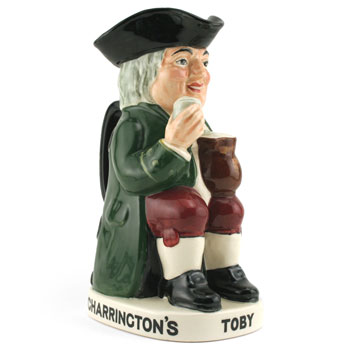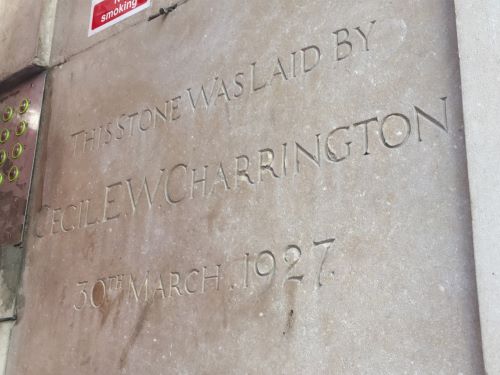
Closed brewery
129 Mile End Road E1 4BG (Tower Hamlets)
First sold beer: Prior to 1757
Brewing ceased: 1975
Robert Westfield entered the brewing industry as an employee in 1738, and by 1757 had set up his own brewery at Bethnal Green in partnership with Joseph Moss. In 1770 the partners built the Anchor Brewery (or Blue Anchor) on a larger site on the Mile End Road near Stepney Green. John Charrington joined the partnership in 1766 and he and his brother Henry were in full control by 1783. Their descendants continued to manage the brewery into the 19th century, and a limited company was registered in 1897.
Among other acquisitions, Charrington took over and closed the historic Red Lion brewery at St Katherine’s Docks in 1934, inheriting the well-known Toby jug logo of previous owners Hoare & Co. The Red Lion was then said to be the oldest brewery in Britain and one of the oldest continuous businesses in London. It likely originated as the brewhouse of the Hospital of St Katherine’s by the Tower, founded in 1147, with the earliest record of commercial brewing from 1492. It subsequently played a major role in the perfection of porter in the 1730s when then-owner Humphrey Parsons (c1676-c1741) became likely the first brewer to mature the beer in large oak vats. By the time of the takeover, it was particularly noted for a bottled pale ale, Toby Ale (~5%), which Charrington continued to brew.
Another notable acquisition was the Abbey Brewery (Meakin & Co, London and Burton Brewery) in Burton upon Trent, giving Charrington a presence in this increasingly important brewing town. This closed in 1925 with production reassigned to London: the building was sold as a maltings before being demolished in the late 1960s.
In 1963, Charrington’s independence fell to the brewery group generally regarded as kicking off ‘merger mania’, United Breweries, established by colourful entrepreneur E P “Eddie” Taylor (1901-89), of Canadian Breweries, originally as a vehicle to market Carling lager in the UK. In 1967 Charrington United merged with Bass Mitchells & Butlers (itself the product of a 1961 merger between the historic Bass brewery in Burton-upon-Trent and large regional Birmingham brewer Mitchells & Butlers) to form Bass Charrington, then the largest brewery group in the UK.

In the early 1970s Charrington was still brewing some cask brands in London: dark Mild (~3.4%), Crown Bitter (~3.6%) and IPA (~3.9%). But the site was mainly functioned to distribute the group’s keg products through its pubs, including its flagship keg ale Toby Bitter (~3%).
Where are they now?
In one of the big brewers’ earliest moves to dismantle their capacity in London, brewing ceased entirely in 1975, though the brands remained available for a while with production transferred to M&B in Birmingham. Bass Charrington retained the brewery offices for some years as their London headquarters though the site was largely redeveloped as the Anchor retail park in the 1980s.
In 2000 the brewing interests of Bass Charrington were sold to Interbrew of Leuven, Belgium, which has since become AB InBev following mergers with Brazil’s AmBev and St Louis, Missouri-based giant Anheuser-Busch. Following intervention from the European Union competition regulator, the Burton brewery and some of the brands including Charrington were sold on in 2001 to Coors of Golden, Colorado, now Molson Coors.
Following the sale, Toby Bitter, in keg and occasionally even in cask, continued to appear intermittently, sometimes contract-brewed, and in the 2020s is still available as a keg product, though at an even lower strength of 2.8% ABV. Toby Ale was brewed by Molson in Québec at least into the mid-2000s (historically Molson was a rival to Canadian Breweries but had merged with its successor company Carling O’Keefe in 1989).
Charrington IPA was recreated in cask and bottle with the consent of Molson Coors in 2015 by Steve Wellington at the Heritage Brewing Co in what was then the National Brewery Centre, the former Bass Museum, in Burton upon Trent. It’s since become part of the regular range, using a vintage recipe at a respectable 4.5% ABV and the original Charrington yeast strain. Heritage subsequently revived another Charrington brand, Oatmeal Stout (4%).
The former Bass Charrington pub arm eventually renamed itself Mitchells & Butlers after the Birmingham brewery, which was closed by Coors in 2002.
Things to see
The most obvious remains of the brewery itself are the two former office buildings on the corner of Mile End Road and Cephas Avenue which remained in use by Bass for some time after the demolition of the rest of the site. 129 Mile End Road E1 4BG is an imposing mid-19th century Grade II-listed yellow brick building. The red brick building behind it, now converted to flats, was added to the office complex in 1927: a plaque laid by one of the Charrington family can be seen in an entrance way off Cephas Avenue.
The wall of the uninviting retail park car park fronting onto Mile End Road is recent but follows the line of the brewery’s main gates and at least makes an attempt at being a gateway feature. There are some genuine rear gates still standing, though, at 16 Nicholas Road E1 4AF: note the shields depicting a C for Charrington and an anchor.
A little further east along Mile End Road at no 137 is Grade II-listed Malpaquet House E1 4AR, a large four-storey house built in 1742. Henry Charrington lived here from 1794 to 1833, and it has an interesting subsequent history. To the west of the brewery site, accessed through a gate between Cleveland Way and Coopers Close, is a secluded row of late 18th century cottages originally built for brewery workers, known as Bellevue Place (E1 4UG). Sadly, another row of brewery cottages behind Stepney Green station, built in 1842 and known as XX Place after one of the brewery’s popular mild ales, is now lost beneath the student flats of Stocks Court (E1 4AH).
The Dickens Inn at St Katherine’s Docks (Marble Quay, St Katharine’s Way E1W 1UH), a converted timber-framed warehouse dating from around 1780, may be the last surviving fragment of Hoare’s Red Lion Brewery. Predating the construction of the docks, which opened in 1828-29, it was once closer to the brewery site but was moved 70 m west in 1975 to facilitate redevelopment. It has no direct connection with Charles Dickens, though was officially opened as a pub in 1976 by his great grandson Cedric Dickens. In the mid-1980s it briefly sold beer from its own off-site brewery, across the river Thames by London Bridge station: see Tooley Street Brewery.
Updated 10 June 2024.
More London breweries
Closed London breweries





Leave a Reply